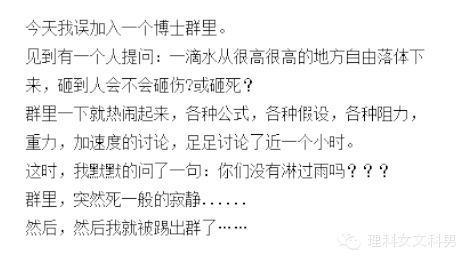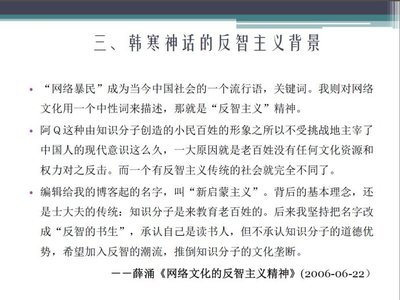呃,以前写过关于American Anti-intellectualism 的paper。这是其中一个reference. 我觉得解释的还算全面。一言两语很难解释清楚这个关乎美国传统的问题,题主可以细细阅读下这篇文章。
A Brief History of Anti-intellectualism in American MediaThe June 2008 cover of the Washington Post Magazine featured reporter Liza Mundy's article "The Amazing Adventures of Supergrad." Under this title ran the teaser, "The most sophisticated, accomplished, entitled graduates ever produced by American colleges are heading into the workplace. And employers are falling all over themselves to vie for their talents."
The lengthy piece portrays Emma Clippinger, then a Brown University junior who was double-majoring in developmental studies and comparative literature, serving as captain of the equestrian team, and helping run Gardens for Health International, an organization she cofounded that focuses on the nutrition of HIV-positive Rwandans. Clippinger also is noted for having worked on Martin Scorsese's The Departed, having interned with the Clinton Foundation, and being fluent in French (along with speaking some Kinyarwanda and Wolof, languages in Rwanda and Senegal, respectively).

Mundy then breathlessly tells her readers that millennials are "one of the most heavily recruited cohorts to enter the American workforce, their hearts and minds incessantly battled over." This generation, made up of perhaps "the best-credentialed graduates ever produced by American colleges," is "computer-literate, well-traveled, hyper-groomed and accustomed to competing for what they want."
It isn't until nearly halfway through that Mundy pauses to ask, "Is this generation of graduates really more qualified for entry-level management jobs than, say, World War II veterans?" She spends several more paragraphs answering that question with a huge yes. As the several-thousand-word article continues, Mundy adds in numerous other unsupported assertions: this is a "generation of achievers" who "like working in teams," "like to exercise," "are unusually oriented toward public service," and so on.
That "employers report that members of this generation are poorer writers" and "their face-to-face skills are sometimes lacking" comes two-thirds of the way through the article, and these criticisms are glossed over as if unimportant. "That not every student feels coveted and wined and dined and solicited and cosseted" appears near the article's end and is similarly not explored. Neither is mention of specific employers looking for new workers who are "patient," have a "sense of urgency," "can work in ambiguous situations," and have majored in "math and computer science," none of these claims seeming well supported by the article.
Mundy's article--while not the standard higher education media fare--is not unique. For decades, national newspapers and magazines, elite ones such as the New York Times and large-circulation ones such as the old Life weekly, have celebrated a tiny upper crust of students: the Rhodes scholar, the literature student publishing her first novel at twenty-one, the computer science student who started a company at nineteen or obtained a patent at twenty. Ostensibly, such articles applaud intellect and education, as well as ancillary circumstances, among them self-discipline, supportive (and often well-off) parents, and creativity.
More significant from a cultural standpoint, though, is the degree to which such stories, long a media staple, represent a freak show of a certain kind, a nonfiction version of a current television show such as The Big Bang Theory. Perhaps the best known earlier case was that of William James Sidis, who entered Harvard in 1909 at age eleven and was profiled in 1937 by the New Yorker under the headline, "Where Are They Now?" Sidis lost an invasion-of-privacy suit against the magazine, which unsurprisingly he filed, since he had long been living in obscurity and the New Yorker was rather gleefully reporting the sad adult lives of child prodigies.
Articles such as "The Amazing Adventures of Supergrad" are unlikely to inspire other young people, should they see such stories (few teenagers read the Washington Post or New York Times). The college students profiled are so superlative that they almost surely would discourage other young people. Very late in Mundy's article, she cites a student who says, "There's too much competition. … I know people who did internships freshman year. … I feel like I'm behind the game. … Oh, man, it's so hard."
Finally, while "supergrads" assign some credit to their college education, such students had often been high achievers in high school, and educational institutions played little role in their accomplishments; sometimes it is suggested that educational institutions are actual or potential hindrances--witness the print and broadcast stories noting that Bill Gates dropped out of Harvard (among other high-tech geniuses who also quit college).
By offering up its periodic freak show of child prodigies such as Sidis or today's supergrads--turning such students, in social scientific terms, into deviants--the US news media engage in anti-intellectualism, here not by failing to cover or hire intellectuals (although they do this, too) but by portraying intellectuals in ways that are explicitly or implicitly negative. In this, the US news media are in the mainstream of American culture.
That anti-intellectualism is mainstream was documented by Richard Hofstadter's Anti-intellectualism in American Life, which won a 1964 Pulitzer Prize. It remains the landmark work on the topic, even though a few significant books and articles on anti-intellectualism preceded it (most notably Merle Curti's The Growth of American Thought in 1943), and even though it has been followed, in recent years, by well-known books from the Left and Right, including Russell Jacoby's The Last Intellectuals, Allan Bloom's The Closing of the American Mind, Richard Posner's Public Intellectuals: A Study of Decline, and Susan Jacoby's The Age of American Unreason. The list lengthens if one adds in broader books about the "dumbing down" of American society.
With the exception of its quite dated chapters 1 and 15, Hofstadter's book remains immensely useful (as well as an enjoyable read). Daniel J. Rigney, now professor emeritus in sociology of knowledge at St. Mary's University, developed a theory of American anti-intellectualism based on Hofstadter's history and other sources. (Hofstadter's book detailed anti-intellectualism in US religion, politics, education, and business back to the early nineteenth century, omitting the anti-intellectualism in the news media that had already been identified by George S. Hage's 1956 doctoral dissertation, "Anti-intellectualism in Newspaper Comment of the Elections of 1828 and 1952.") Briefly, and at the risk of oversimplifying and overgeneralizing, Rigney (and Hofstadter) found three types of anti-intellectualism: (1) "religious antirationalism," the view that emotion is warm (that is, good) and reason cold (bad), an outlook often complemented by absolute systems of belief (primarily conservative Protestantism); (2) "populist anti-elitism," public skepticism first of the patrician class of "gentlemen politicians" and old money (which still flares up, as against George H. W. Bush) and later public hostility toward progressive politics and support of such figures as Joe McCarthy or George Wallace; and (3) "unreflective instrumentalism," beliefs and behavior indicating that knowledge is worthless unless it immediately and directly leads to material gain, such as profits or higher salaries and wages.
The national magazine coverage of higher education that I studied for my 2004 book, Anti-intellectualism in American Media, spanned from 1944 (when the GI Bill was passed) to 1996. I organized evidence that the US news media both were and were not anti-intellectual using the individual manifestations of Rigney's three major types as a theoretical framework. Hence, for antirationalism, I looked to examples of news coverage that were either opposed to reason or not, opposed to science or not, defending authority or not, and favoring or opposing deintellectualized curricula. For populist anti-elitism, I similarly looked for evidence of advocating "common people's" interests, support for right-wing populism, support for left-wing populism, devaluation of book learning and academic standards, and beliefs that intellectuals are snobs. For unreflective instrumentalism, I covered suppression of ethics questions, impatience with theory and ideas, pressure for vocationalism in the humanities and social sciences, and advocacy of less autonomy in education.
The amount and quality of coverage of each of these three topics varied greatly, of course. In general, I concluded that the national magazines studied were mostly anti-intellectual, although none of them was entirely so at any time, and certainly not always or in all ways.
But what was perhaps even more damning was that the magazines devoted almost no attention at all to the core functions of higher education: teaching, learning, researching, thinking, debating, studying, and writing. Instead, what I found was the "college years": coverage overwhelmingly portraying colleges and universities as places where students play and watch sports, date and possibly marry, drink and take drugs, protest, join fraternities and sororities, go on vacation, avoid the draft, escape their parents, and network and apply for jobs.
Overall, I would not be surprised--based on national media coverage spanning decades--if Americans who have not been to college have very little idea what college is like (except for something a lot like high school, whether it is or not), and Americans who do attend college might be excused if they think that learning is not the top priority in higher education.
Although I have not done a formal follow-up study, I see little if any reason to believe that news media coverage of higher education has substantively changed since 1996 or that the tone of coverage is now substantially different in newspapers or on television, radio, or the World Wide Web from what it was in major national magazines from the 1940s until the 1990s. In addition to the higher education topics that magazines cover, newspapers' coverage of higher education includes a high percentage of articles about university budgets, tuition increases, faculty salary increases, appointments to boards of regents and trustees, national and international rankings of local universities, localized national stories such as endowment sizes and university presidents' salaries, crime on or near campuses, celebrity graduation speakers, and health issues on campus such as epidemics of communicable diseases. News coverage of higher education on local and national television, whether broadcast or cable, is minimal and certainly does not include topics not covered by newspapers and magazines. In any case, the common denominator is that what is not getting covered is the education part of "higher education."
For this Academe article, I read scores of higher education articles in major national magazines published since 2005, overrepresenting Time magazine, the middlebrow periodical that figured prominently in my book, and skipping coverage purely of sports. Emphasized in coverage have been elite US universities' deals with foreign universities (in the United Arab Emirates, Qatar, China, and India), big tuition hikes and changes in federal student loan and grant programs, underrepresentation of minorities and the poor, booming community colleges, and--in right-wing publications--complaints about liberal campuses and useless degrees.
New since my original study are the international agreements, but also coverage of for-profit institutions (accredited and not--see Barry Yeoman's article in this issue of Academe); college graduation rates (an area in which the United States is falling behind other countries); application coaching; learning assessment; online degrees; colleges "going green"; college rankings; university presidents not as public intellectuals but as quasi-politicians (for example, Gordon Gee of Ohio State University) or as crooks; skyrocketing textbook costs; security (especially after the Virginia Tech massacre); early admissions; and the dishonesty of institutions in marketing themselves and higher education generally, particularly by not collecting or not sharing with prospective students information on completion times, graduation rates, total costs, evidence of learning, employment prospects, job placement rates, campus crime rates, and so on. (An American Association of Collegiate Registrars official says college marketing materials should be marked "buyer beware," as reported in the September 2009 American Prospect.)
I found a little more attention to college drop-out rates and the number of graduates in jobs that don't require a college degree--but on that basis alone the United States has had an oversupply of graduates since the 1960s.
The only mentions of curriculum in this coverage were a few anti-intellectual sentences in some articles and a very few articles on whether university education is too impractical (or at least not practical enough) for today's jobs, on assessment, or on the fact that "anywhere from a third to a half [of college students] require remediation of basic skills," as Diane Ravitch put it, because "our K-12 system is not up to it."
Extremely rare are statements such as those made in the New Yorker (June 7, 2010) by Rebecca Mead, who wrote that "an argument might be made in favor of a student's pursuing an education that is less, rather than more, pragmatic," or in Time (February 24, 2010) by Ramesh Ponnuru, who wrote that "the purpose of a liberal-arts education is to produce well-rounded citizens rather than productive workers."
Also as rare as ever are quotes from students, who supposedly are the reason why colleges and universities exist in the first place; any criticism by higher education institutions of how the news media cover them; or any sense that all students (not only Emma Clippinger) have a great deal of responsibility for their own learning. In other words, lacking is recognition that it is not the sole responsibility of colleges and universities to make students "learn to love learning," as Bates College president Elaine Tuttle Hansen put it.
Two questions are immediately obvious here. The first is how and why the US news media manage to cover an industry and profession as huge and important as higher education without reporting much on its core functions (granted, a small percentage of the medical and other scientific research on campuses gets covered, but such coverage only underscores the lack of news media attention to all other faculty research). The second, more cynical question is whether it is in the best interest of the news media to encourage the general population to be anti-intellectual.
Either question can be answered quickly and too easily from one of several perspectives. If, for example, one believes that the news media are just another hegemonic institution, one can claim that it is in journalists' interest to do whatever they can to retain and exercise their own power while limiting that of higher education. Or one could say that the general-interest, mass-audience news media aren't very good at covering anything, so why would higher education be any different? Or one could suggest that higher education news may not be very popular with consumers, and even news media, let alone other mass media, are interested only in maximizing satisfied audiences these days. I might float the idea that most US news media are so anti-intellectual that they don't know how anti-intellectual they are (certainly they make no attempt to compare themselves with the staff of, say, the United Kingdom's Guardian--one of many intellectual newspapers and magazines for a mass audience across the Atlantic). There's at least some truth to each of these arguments, to be sure.
But, of course, it's more complex than that. Rank-and-file journalists in the United States are far less political or ideological than either the American Right claims they are or than American liberals sometimes would like them to be. And consider that print media and wire services still are not very good at giving consumers more of what they want and less of what they are getting too much of. One also must think about the conventions of journalism. As Edward Caudill explains in Darwinism in the Press: The Evolution of an Idea, ideas and theories are not easy for journalists to report on. Ideas "may have little inherent newsworthiness. [A theory] lacks both timeliness and immediate significance for the audience. … Although a theory may pertain to all things at all times, it does not have the urgency, event-of-the-moment aura, that news favors. Proximity is another common news standard that ideas fail to meet."
"Even if such a theory entered the news process," Caudill concludes, "the reporter still has the problem of converting the information into 'news,' … [of making information] fit into an appropriate news category. Stories about ideas and theories lose potential impact by being categorized as 'soft' or feature news rather than hard news. … Just because an idea is important does not mean that it is exciting or even interesting by news standards." (Thus the number of university press releases that go right into the trash can, deservedly or not.)
But what is more fascinating, if not also more troubling, about the relationship between higher education and the news media in the United States is that it consists of a series of paradoxes, if not outright hypocrisy: US mass media over the past fifteen years have increasingly wanted to sell a "class," not "mass," audience to their advertisers, but have done little to attract, develop, or retain an educated audience. US news media, having spent centuries trying to deliver news and information that audiences would find difficult or impossible to obtain anywhere else, have since the advent of the World Wide Web essentially given up that role without really trying to preserve, let alone enhance, it. (In fact, the US news media--despite being in the information and ideas business--are just another industry in which it is relatively easy to not be hired because one is "overqualified," that is, because one has, in a manager's opinion, too many college degrees.) News media companies have claimed that they need journalists who are more technologically trained than ever, but these companies do almost nothing--in terms of equipment, training, or money--to help university journalism professors teach advanced technological skills. Perhaps most strangely, US news media executives are still likely to criticize journalism schools while overwhelmingly relying on them for new employees and often being J-school graduates themselves.
US news media could not maintain their anti-intellectualism without widespread public acceptance, but schools of journalism must accept their share of the blame. US journalists historically came from blue-collar backgrounds; nineteenth-century newspapers were staffed by one or two college-graduate editors and high school-dropout reporters. The percentage of US journalists with college degrees did not reach 50 percent until about 1970 but has kept increasing since then. Today, close to 100 percent of journalists have bachelors' degrees and well over 50 percent have journalism degrees. J-schools thus had a historic opportunity to become a pro-intellectual force in US mass media. They largely failed.
Both because of and despite an increase in the percentage of J-school professors holding terminal degrees, mutual suspicion held sway for decades between "chi-squares" (faculty members with terminal degrees) and "green eyeshades" (retired journalists on the faculty). Even today, most mass-media textbooks are written by eyeshades who cite little (if any) scholarly research, while chi-squares publish research that is, for the most part, not useful to the media industry and does not push the envelope of theory. J-schools, still balancing the two groups, often have research requirements for tenure that are low, ignored, or differentiated, resulting in mean numbers of scholarly journal articles and books of about one and close to zero, respectively. And recently, J-school curricula have become more anti-intellectual, as courses in media history, media management, and public-affairs reporting have been marginalized or eliminated. In their place have come an explosion of courses, majors, and endowed chairs in sports journalism, sports information and public relations, sports marketing, and even sports management; in e-commerce; and in web design, animation, computer games, and other fields that involve both communication and technology.
If US higher education's future is dependent on mass public opinion, that mass public opinion is largely dependent on the news media, and journalism is a counterintuitively anti-intellectual profession staffed primarily by graduates of anti-intellectual journalism schools, it is no surprise that public funding of higher education was declining before the Great Recession, that graduation rates barely creep up, and that what members of the general public know about universities is usually limited to their semiprofessional sports programs (which are incorrectly assumed to be profitable). US colleges and universities, including their J-schools, need to improve their products: their curricula and their graduates.
Richard Hofstadter
~~~~~~~~
Claussen, Dane S. "A Brief History Of Anti-Intellectualism In American Media." Academe 97.3 (2011): 8-13. ERIC. Web. 25 Feb. 2014.
 爱华网
爱华网


